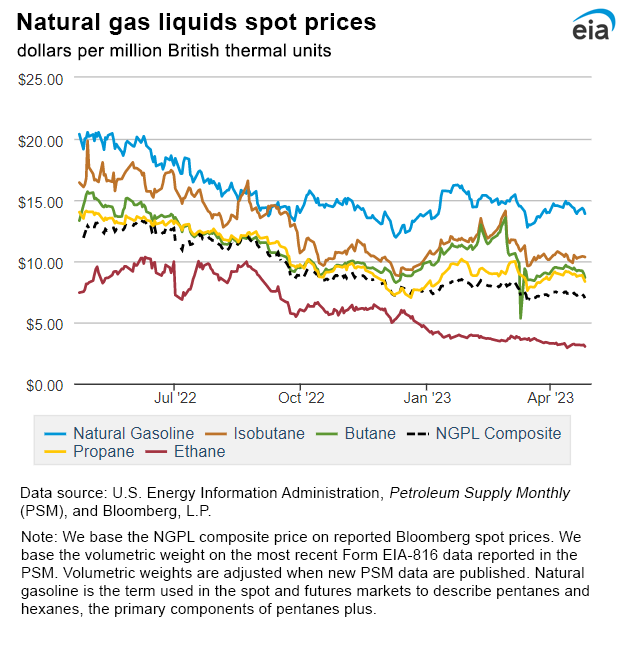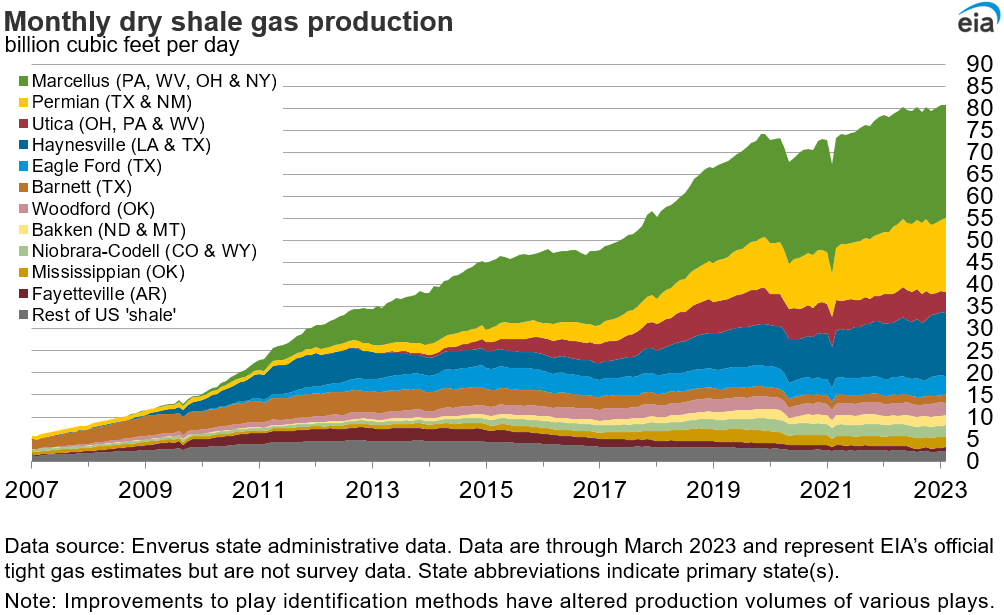In the News:
Mild 2022–2023 winter leads to record-high end-of-season storage inventories in Europe
European natural gas storage inventories as of April 1, 2023, were 56% full—the highest level on record for the end of the heating season, according to data from Gas Storage Europe’s Aggregated Gas Storage Inventory (AGSI+). European storage stocks at the end of January, February, and March 2023 were the highest ever recorded for those months. This year's end-of-season storage stocks of 2.02 trillion cubic feet (Tcf) (as of March 31) exceeded the previous record of 1.98 Tcf at the end of winter 2019–2020 and were significantly above the five-year (2018–2022) average of 1.21 Tcf.
Europe’s high levels of natural gas in storage are the result of an exceptionally warm winter that reduced heating demand, lower natural gas consumption resulting in part from a Europe-wide effort to conserve natural gas, and record levels of liquefied natural gas (LNG) imports, which helped offset lower imports by pipeline from Russia.
The winter of 2022–2023 was Europe’s second-warmest winter on record, according to data from the National Oceanic and Atmospheric Administration (NOAA). October 2022 and January 2023 were the warmest on record in Europe. Most of the world’s LNG (97%) is consumed in the Northern Hemisphere, which experienced the fifth-warmest winter on record. In Asia, key LNG-consuming countries reduced spot LNG imports, as natural gas consumption remained low and on-site LNG storage, which has limited capacity, remained full. In Japan, on-site LNG storage was at all-time high each month from October 2022 through January 2023, according to data from Japan’s Agency for Natural Resources and Energy. Reduced demand for spot LNG in Asia led to record volumes of LNG being shipped to Europe.
In 2022, European governments enacted policies requiring storage operators to maximize storage injections during the refill season to assure availability of natural gas supply during winter. As a result, storage stocks on November 1—the traditional start of the heating season—were 95% full, exceeding the 12-year (2011–2022) average of 89% and greatly exceeding storage stocks at the start of the heating season in 2021.
Last year, Europe (EU-27 and the UK), which historically rely on natural gas imports to meet more than 80% of natural gas consumption, shifted away from pipeline imports from Russia. Russia’s natural gas exports to Europe, which averaged 13.1 billion cubic feet per day (Bcf/d) from 2019 through 2021, declined to 1.4 Bcf/d by September 2022 and averaged 1.1 Bcf/d during the past winter (November 2022 through March 2023). Although natural gas imports by pipeline from Norway increased last year to 11.3 Bcf/d (3% higher compared with 2021) and averaged 11.5 Bcf/d during the winter, a significant increase in LNG imports helped to refill storage inventories and balance the market, offsetting the decline in pipeline imports from Russia.
Europe’s LNG imports remained high during 2022, averaging 14.9 Bcf/d, 65% (5.8 Bcf/d) higher than in 2021. During this past winter, LNG imports averaged 16.3 Bcf/d, reaching an all-time monthly high of 17.9 Bcf/d in December. Europe was the main destination for U.S. LNG exports in 2022.
The United States remained the largest LNG supplier to Europe for the second year in a row, accounting for 44% (6.5 Bcf/d) of total LNG imports during 2022, followed by Qatar at 17% (2.5 Bcf/d), Russia at 12% (1.8 Bcf/d), and 14 other LNG-producing countries at a combined 26% (3.8 Bcf/d).
Market Highlights:
(For the week ending Wednesday, April 26, 2023)Prices
- Henry Hub spot price: The Henry Hub spot price fell 1 cent from $2.20 per million British thermal units (MMBtu) last Wednesday to $2.19/MMBtu yesterday.
- Henry Hub futures prices: The May 2023 NYMEX contract expired yesterday at $2.117/MMBtu, down 11 cents from last Wednesday. The June 2023 NYMEX contract price decreased to $2.305/MMBtu, down 9 cents from last Wednesday to yesterday. The price of the 12-month strip averaging June 2023 through May 2024 futures contracts declined 4 cents to $3.042/MMBtu.
- Select regional spot prices: Natural gas spot price changes were mixed this report week (Wednesday, April 19, to Wednesday, April 26), falling in locations west of the Rockies and rising in most eastern locations. Price changes at major pricing hubs this report week ranged from a decrease of $1.42/MMBtu at PG&E Citygate to an increase of nearly 16 cents/MMBtu at the Houston Ship Channel.
- Prices in most markets from the Midwest to the East Coast increased this report week as cooler temperatures moved across the United States, contributing to an increase in natural gas consumption for heating. Price changes were relatively small in most markets, which is typical for this time of year when moderate temperatures lead to less natural gas demand for heating or air conditioning. At the Chicago Citygate, the price increased 4 cents from $1.94/MMBtu last Wednesday to $1.98/MMBtu yesterday. In the Midwest, natural gas consumption increased 22% (2.3 billion cubic feet per day [Bcf/d]), according to data from S&P Global Commodity Insights. Natural gas consumption in the residential and commercial sectors increased 44% (2.0 Bcf/d). In the Chicago Area, temperatures averaged 46°F, resulting in 39 more heating degree days (HDDs) than normal and 53 more than last week.
- At the Algonquin Citygate, which serves Boston-area consumers, the price rose 13 cents from $1.96/MMBtu last Wednesday to $2.09/MMBtu yesterday. At the Transcontinental Pipeline Zone 6 trading point for New York City, the price increased 8 cents from $1.73/MMBtu last Wednesday to $1.81/MMBtu yesterday. Natural gas consumption in the Northeast increased 11% (1.7 Bcf/d), which was led by a 36% (1.8 Bcf/d) increase in residential and commercial sector consumption.
- Although prices in West Coast markets continue to be the highest in the United States, they declined from last week’s levels. The price at PG&E Citygate in Northern California fell $1.42 from $6.17/MMBtu last Wednesday to $4.75/MMBtu yesterday. The price at SoCal Citygate in Southern California decreased 80 cents from $7.66/MMBtu last Wednesday to $6.86/MMBtu yesterday. The price at Sumas on the Canada-Washington border fell 84 cents from $3.63/MMBtu last Wednesday to $2.79/MMBtu yesterday. According to S&P Global Commodity Insights, natural gas consumption in the Western region decreased 9% (0.8 Bcf/d), which was led by a 29% (1.0 Bcf/d) decrease in residential and commercial sector consumption.
- International futures prices: International natural gas futures prices decreased this report week. According to Bloomberg Finance, L.P., weekly average front-month futures prices for liquefied natural gas (LNG) cargoes in East Asia fell 66 cents to a weekly average of $11.90/MMBtu. Natural gas futures for delivery at the Title Transfer Facility (TTF) in the Netherlands fell 51 cents to a weekly average of $12.84/MMBtu. In the same week last year (week ending April 27, 2022), the prices were $25.26/MMBtu in East Asia and $31.29/MMBtu at TTF.
- Natural gas plant liquids (NGPL) prices: The natural gas plant liquids composite price at Mont Belvieu, Texas, fell by 16 cents/MMBtu, averaging $7.18/MMBtu for the week ending April 26. Weekly average ethane prices rose 1%, while natural gas prices at the Houston Ship Channel rose 12%, narrowing the ethane premium to natural gas by 13% week over week. Ethylene spot prices fell by 2%, decreasing the ethylene to ethane premium by 4%. Propane prices fell 4%, while the Brent crude oil price fell by 6%, resulting in a 9% decrease in the propane discount relative to crude oil. Normal butane prices fell 4% and natural gasoline prices fell 2%, while isobutane prices rose 1%.
Daily spot prices by region are available on the EIA website.
Supply and Demand
- Supply: According to data from S&P Global Commodity Insights, the average total supply of natural gas rose by 0.9% (1.0 Bcf/d) compared with the previous report week. Dry natural gas production grew by 0.7% (0.7 Bcf/d), and average net imports from Canada increased by 6.5% (0.3 Bcf/d) from last week.
- Demand: Total U.S. consumption of natural gas rose by 6.7% (4.5 Bcf/d) compared with the previous report week, according to data from S&P Global Commodity Insights. In the residential and commercial sectors, natural gas consumption increased by 21.1% (3.6 Bcf/d) as below-normal temperatures spread across much of the United States this week. Natural gas consumed for power generation rose by 1.9% (0.5 Bcf/d), and natural gas consumed by the industrial sector also rose by 1.9% (0.4 Bcf/d). Natural gas exports to Mexico increased 9.4% (0.5 Bcf/d). Natural gas deliveries to U.S. LNG export facilities (LNG pipeline receipts) averaged 14.0 Bcf/d, or 0.5 Bcf/d lower than last week.
Liquefied Natural Gas (LNG)
- Pipeline receipts: Overall weekly average natural gas deliveries to U.S. LNG export terminals decreased by 3.3% (0.5 Bcf/d) week over week to average 14.0 Bcf/d this report week, according to data from S&P Global Commodity Insights. Natural gas deliveries to terminals in South Texas decreased by 9.0% (0.4 Bcf/d) to 4.1 Bcf/d, while deliveries to terminals in South Louisiana decreased by 0.8% (0.1 Bcf/d) to 8.6 Bcf/d. Natural gas deliveries to terminals outside the Gulf Coast were essentially unchanged at 1.3 Bcf/d.
- Vessels departing U.S. ports: Twenty-eight LNG vessels (nine from Sabine Pass; four each from Cameron, Corpus Christi, Cove Point, and Freeport; and three from Calcasieu Pass) with a combined LNG-carrying capacity of 104 Bcf departed the United States between April 20 and April 26, according to shipping data provided by Bloomberg Finance, L.P.
Rig Count
- According to Baker Hughes, for the week ending Tuesday, April 18, the natural gas rig count increased by 2 rigs from a week ago to 159 rigs. The Eagle Ford added one rig, two rigs were added in unidentified producing regions, and the Permian dropped one rig. The number of oil-directed rigs increased by 3 rigs from a week ago to 591 rigs. The Permian added three rigs, three rigs were added in unidentified producing regions, and the Cana Woodford, Eagle Ford, and Mississippian dropped one rig each. The total rig count, which includes 3 miscellaneous rigs, stands at 753, or 58 more rigs than last year at this time.
Storage
- The net injections into storage totaled 79 Bcf for the week ending April 21, compared with the five-year (2018–2022) average net injections of 43 Bcf and last year's net injections of 42 Bcf during the same week. Working natural gas stocks totaled 2,009 Bcf, which is 365 Bcf (22%) more than the five-year average and 525 Bcf (35%) more than last year at this time.
- According to The Desk survey of natural gas analysts, estimates of the weekly net change to working natural gas stocks ranged from net injections of 69 Bcf to 83 Bcf, with a median estimate of 77 Bcf.
See also:
Top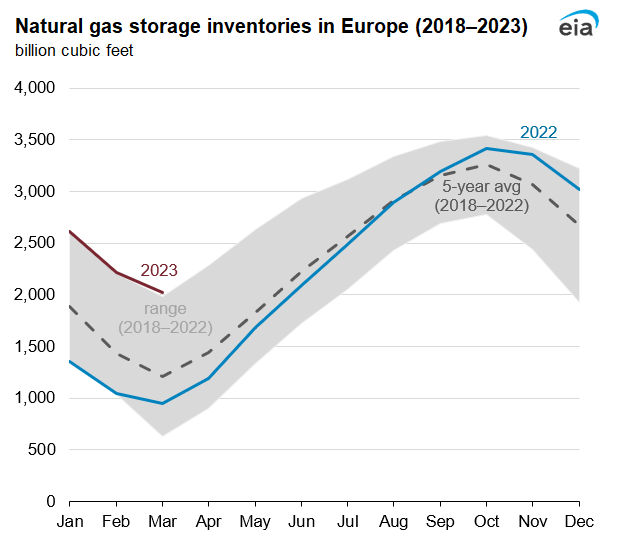
Data source: Gas Infrastructure Europe, Aggregated Gas Storage Inventory (AGSI+)
Note: Figures shown are for the last day of each month. Storage inventory levels are converted from terawatthours to billion cubic feet using a conversion factor of 3,602 kilowatthours per cubic foot.
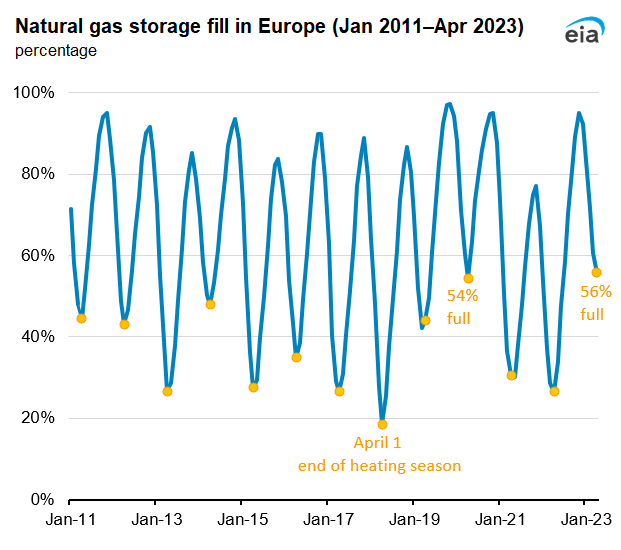
Data source: Gas Infrastructure Europe, Aggregated Gas Storage Inventory (AGSI+)
Note: Percentages calculated by AGSI+. Figures shown are for the first day of each month.
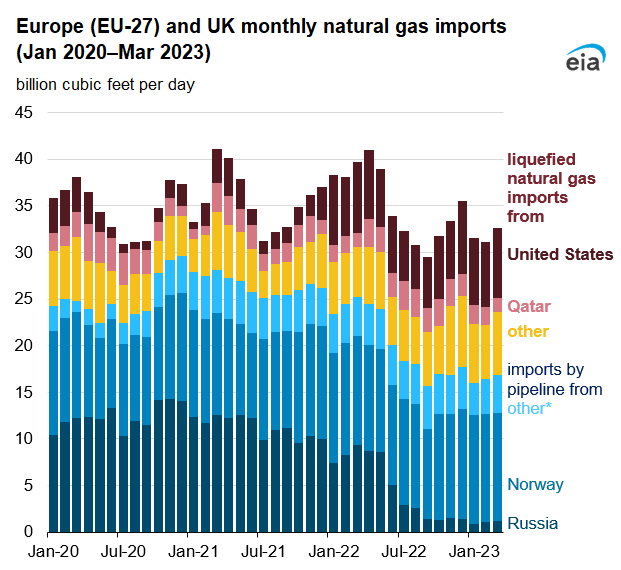
Data source: Refinitiv Eikon, CEDIGAZ
Note: *Pipeline imports from "other" include imports from Azerbaijan and North Africa (Algeria and Libya).
Imports of natural gas via pipeline or as liquefied natural gas do not include flows to Türkiye.
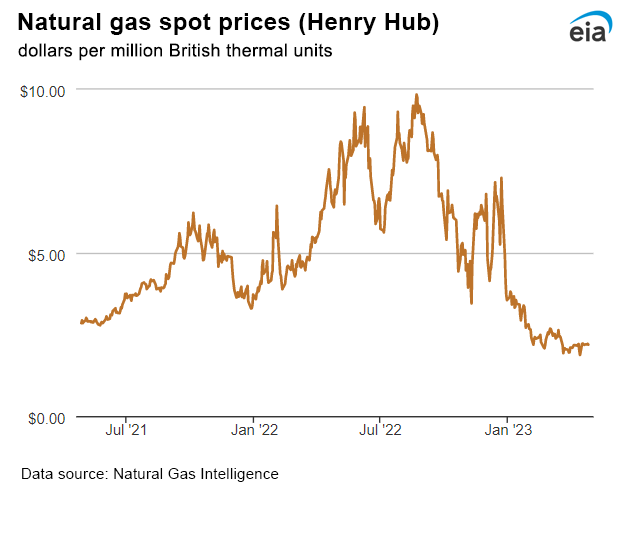
| Spot Prices ($/MMBtu) | Thu, 20-Apr |
Fri, 21-Apr |
Mon, 24-Apr |
Tue, 25-Apr |
Wed, 26-Apr |
|---|---|---|---|---|---|
| Henry Hub |
2.18 |
2.19 |
2.20 |
2.21 |
2.19 |
| New York |
1.67 |
1.61 |
2.05 |
1.93 |
1.81 |
| Chicago |
1.98 |
2.13 |
2.20 |
2.15 |
1.98 |
| Cal. Comp. Avg.* |
3.85 |
3.63 |
3.87 |
3.74 |
3.48 |
| Futures ($/MMBtu) | |||||
| May contract | 2.249 |
2.233 |
2.273 |
2.307 |
2.117 |
| June contract |
2.427 |
2.408 |
2.471 |
2.437 |
2.305 |
| *Avg. of NGI's reported prices for: Malin, PG&E Citygate, and Southern California Border Avg. | |||||
| Source: NGI's Daily Gas Price Index | |||||
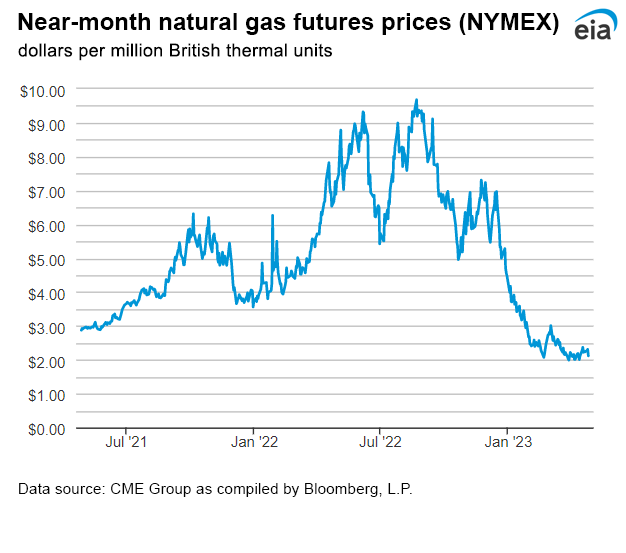
| U.S. natural gas supply - Gas Week: (4/20/23 - 4/26/23) | |||
|---|---|---|---|
Average daily values (billion cubic feet) |
|||
this week |
last week |
last year |
|
| Marketed production | 113.9 |
113.2 |
108.6 |
| Dry production | 101.5 |
100.8 |
95.9 |
| Net Canada imports | 5.0 |
4.7 |
5.4 |
| LNG pipeline deliveries | 0.1 |
0.1 |
0.1 |
| Total supply | 106.5 |
105.6 |
101.4 |
|
Data source: S&P Global Commodity Insights | |||
| U.S. natural gas consumption - Gas Week: (4/20/23 - 4/26/23) | |||
|---|---|---|---|
Average daily values (billion cubic feet) |
|||
this week |
last week |
last year |
|
| U.S. consumption | 71.9 |
67.4 |
67.1 |
| Power | 28.8 |
28.3 |
25.4 |
| Industrial | 22.7 |
22.2 |
22.9 |
| Residential/commercial | 20.5 |
16.9 |
18.9 |
| Mexico exports | 5.6 |
5.1 |
6.1 |
| Pipeline fuel use/losses | 6.9 |
6.7 |
6.5 |
| LNG pipeline receipts | 14.0 |
14.5 |
12.1 |
| Total demand | 98.4 |
93.7 |
91.8 |
|
Data source: S&P Global Commodity Insights | |||
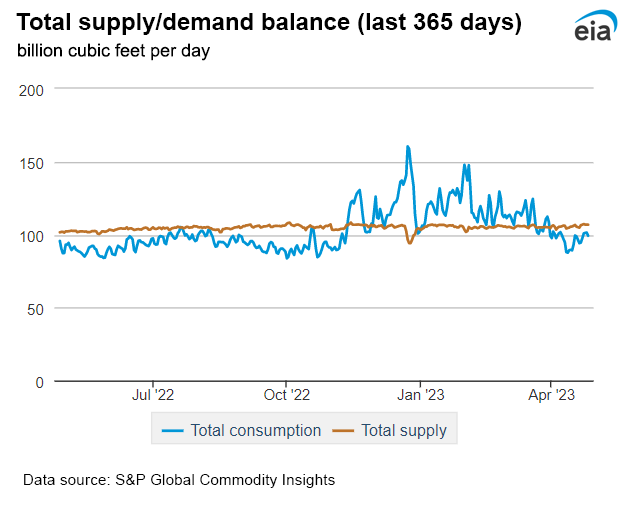
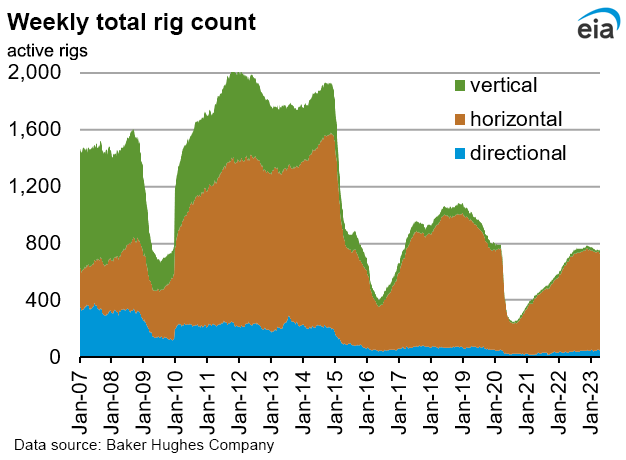
| Rigs | |||
|---|---|---|---|
Tue, April 18, 2023 |
Change from |
||
last week |
last year |
||
| Oil rigs | 591 |
0.5% |
7.7% |
| Natural gas rigs | 159 |
1.3% |
10.4% |
| Note: Excludes any miscellaneous rigs | |||
| Rig numbers by type | |||
|---|---|---|---|
Tue, April 18, 2023 |
Change from |
||
last week |
last year |
||
| Vertical | 18 |
-5.3% |
-28.0% |
| Horizontal | 687 |
0.6% |
7.5% |
| Directional | 48 |
4.3% |
54.8% |
| Data source: Baker Hughes Company | |||
| Working gas in underground storage | ||||
|---|---|---|---|---|
Stocks billion cubic feet (Bcf) |
||||
| Region | 2023-04-21 |
2023-04-14 |
change |
|
| East | 390 |
363 |
27 |
|
| Midwest | 468 |
450 |
18 |
|
| Mountain | 90 |
84 |
6 |
|
| Pacific | 90 |
83 |
7 |
|
| South Central | 971 |
949 |
22 |
|
| Total | 2,009 |
1,930 |
79 |
|
| Data source: U.S. Energy Information Administration Form EIA-912, Weekly Underground Natural Gas Storage Report | ||||
| Working gas in underground storage | |||||
|---|---|---|---|---|---|
Historical comparisons |
|||||
Year ago (4/21/22) |
5-year average (2018-2022) |
||||
| Region | Stocks (Bcf) |
% change |
Stocks (Bcf) |
% change |
|
| East | 238 |
63.9 |
286 |
36.4 |
|
| Midwest | 308 |
51.9 |
344 |
36.0 |
|
| Mountain | 90 |
0.0 |
93 |
-3.2 |
|
| Pacific | 171 |
-47.4 |
184 |
-51.1 |
|
| South Central | 677 |
43.4 |
738 |
31.6 |
|
| Total | 1,484 |
35.4 |
1,644 |
22.2 |
|
| Data source: U.S. Energy Information Administration Form EIA-912, Weekly Underground Natural Gas Storage Report | |||||
| Temperature – heating & cooling degree days (week ending Apr 20) | ||||||||
|---|---|---|---|---|---|---|---|---|
HDDs |
CDDs |
|||||||
| Region | Current total |
Deviation from normal |
Deviation from last year |
Current total |
Deviation from normal |
Deviation from last year |
||
| New England | 79 |
-51 |
-36 |
2 |
2 |
2 |
||
| Middle Atlantic | 60 |
-52 |
-54 |
5 |
5 |
4 |
||
| E N Central | 87 |
-28 |
-75 |
2 |
2 |
2 |
||
| W N Central | 104 |
-1 |
-77 |
1 |
0 |
1 |
||
| South Atlantic | 25 |
-28 |
-37 |
21 |
5 |
-4 |
||
| E S Central | 33 |
-15 |
-34 |
2 |
-3 |
1 |
||
| W S Central | 19 |
-2 |
-4 |
30 |
8 |
-5 |
||
| Mountain | 125 |
16 |
15 |
3 |
-5 |
-6 |
||
| Pacific | 95 |
32 |
16 |
0 |
-3 |
0 |
||
| United States | 73 |
-13 |
-35 |
9 |
2 |
-1 |
||
|
Data source: National Oceanic and Atmospheric Administration Note: HDDs=heating degree days; CDDs=cooling degree days | ||||||||
Average temperature (°F)
7-day mean ending Apr 20, 2023
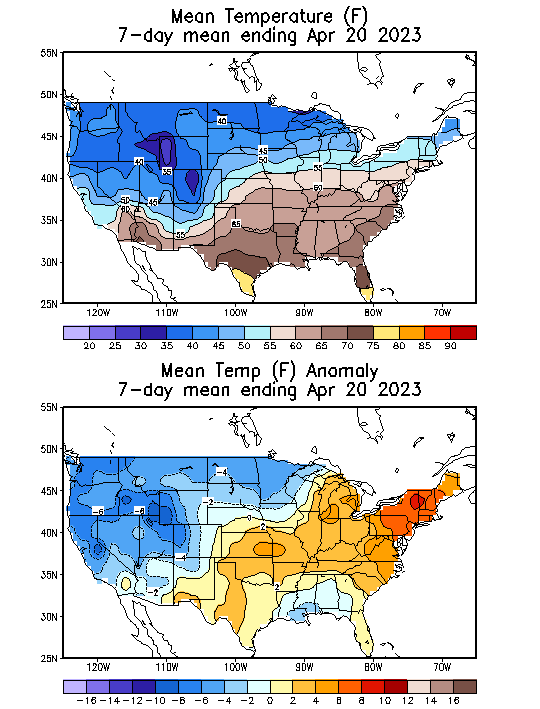
Data source: National Oceanic and Atmospheric Administration
Deviation between average and normal temperature (°F)
7-day mean ending Apr 20, 2023

Data source: National Oceanic and Atmospheric Administration

